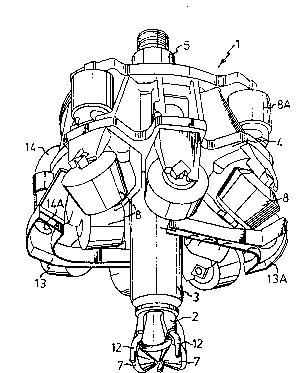Some of the information on this Web page has been provided by external sources. The Government of Canada is not responsible for the accuracy, reliability or currency of the information supplied by external sources. Users wishing to rely upon this information should consult directly with the source of the information. Content provided by external sources is not subject to official languages, privacy and accessibility requirements.
Any discrepancies in the text and image of the Claims and Abstract are due to differing posting times. Text of the Claims and Abstract are posted:
| (12) Patent Application: | (11) CA 2182605 |
|---|---|
| (54) English Title: | SYSTEM, METHOD AND CUTTERHEAD FOR DRY FULL-AREA DRILLING |
| (54) French Title: | SYSTEME, PROCEDE ET TETE DE COUPE POUR FORAGE A SEC A SURFACE PLEINE |
| Status: | Deemed Abandoned and Beyond the Period of Reinstatement - Pending Response to Notice of Disregarded Communication |
| (51) International Patent Classification (IPC): |
|
|---|---|
| (72) Inventors : |
|
| (73) Owners : |
|
| (71) Applicants : |
|
| (74) Agent: | SMART & BIGGAR LP |
| (74) Associate agent: | |
| (45) Issued: | |
| (86) PCT Filing Date: | 1995-02-01 |
| (87) Open to Public Inspection: | 1996-05-09 |
| Examination requested: | 2001-11-15 |
| Availability of licence: | N/A |
| Dedicated to the Public: | N/A |
| (25) Language of filing: | English |
| Patent Cooperation Treaty (PCT): | Yes |
|---|---|
| (86) PCT Filing Number: | PCT/SE1995/000092 |
| (87) International Publication Number: | WO 1996013649 |
| (85) National Entry: | 1996-08-01 |
| (30) Application Priority Data: | ||||||
|---|---|---|---|---|---|---|
|
In a method for use in dry, rotary, crushing
full-area drilling, use is made of suction air alone for
removing cuttings produced during drillings. To carry
out the method, two suction nozzles (13) are arranged
on the underside of a cutterhead (1), These nozzles
together have a substantially diametrical extent and the
length of a radius on the cutterhead and are provided with
suction intakes (14A) in the vicinity of the periphery of
the cutterhead. The suction intakes (14A) are connectible
a common suction channel (11) in the drill string (6) of
the cutterhead. The suction channel (11) has substantially
constant diameter.
Un procédé de forage rotatif à sec par broyage sur surface pleine consiste à utiliser exclusivement de l'air d'aspiration pour éliminer des déchets de forage. Pour appliquer ce procédé, on dispose deux ajutages d'aspiration (13) sur la face intérieure d'une tête de coupe (1). Ces ajutages présentent conjointement une portée diamétrale et séparément une longueur correspondant au rayon de la tête, et ils sont dotés d'entrées d'aspiration (14A), situées près de la périphérie de cette tête de coupe, pouvant être raccordées à une conduite d'aspiration commune (11) intégrée au train de tiges (6) de la tête. Cette conduite d'aspiration (11) représente un diamètre pratiquement constant.
Note: Claims are shown in the official language in which they were submitted.
Note: Descriptions are shown in the official language in which they were submitted.

2024-08-01:As part of the Next Generation Patents (NGP) transition, the Canadian Patents Database (CPD) now contains a more detailed Event History, which replicates the Event Log of our new back-office solution.
Please note that "Inactive:" events refers to events no longer in use in our new back-office solution.
For a clearer understanding of the status of the application/patent presented on this page, the site Disclaimer , as well as the definitions for Patent , Event History , Maintenance Fee and Payment History should be consulted.
| Description | Date |
|---|---|
| Inactive: IPC from MCD | 2006-03-12 |
| Inactive: IPC from MCD | 2006-03-12 |
| Inactive: IPC from MCD | 2006-03-12 |
| Inactive: IPC from MCD | 2006-03-12 |
| Time Limit for Reversal Expired | 2005-02-01 |
| Application Not Reinstated by Deadline | 2005-02-01 |
| Deemed Abandoned - Failure to Respond to Maintenance Fee Notice | 2004-02-02 |
| Letter Sent | 2001-12-10 |
| Inactive: Status info is complete as of Log entry date | 2001-12-10 |
| Inactive: Application prosecuted on TS as of Log entry date | 2001-12-10 |
| Request for Examination Requirements Determined Compliant | 2001-11-15 |
| All Requirements for Examination Determined Compliant | 2001-11-15 |
| Application Published (Open to Public Inspection) | 1996-05-09 |
| Abandonment Date | Reason | Reinstatement Date |
|---|---|---|
| 2004-02-02 |
The last payment was received on 2003-01-21
Note : If the full payment has not been received on or before the date indicated, a further fee may be required which may be one of the following
Please refer to the CIPO Patent Fees web page to see all current fee amounts.
| Fee Type | Anniversary Year | Due Date | Paid Date |
|---|---|---|---|
| MF (application, 3rd anniv.) - standard | 03 | 1998-02-02 | 1998-01-22 |
| MF (application, 4th anniv.) - standard | 04 | 1999-02-01 | 1999-01-22 |
| MF (application, 5th anniv.) - standard | 05 | 2000-02-01 | 2000-01-18 |
| MF (application, 6th anniv.) - standard | 06 | 2001-02-01 | 2001-01-19 |
| Request for examination - standard | 2001-11-15 | ||
| MF (application, 7th anniv.) - standard | 07 | 2002-02-01 | 2002-01-24 |
| MF (application, 8th anniv.) - standard | 08 | 2003-02-03 | 2003-01-21 |
Note: Records showing the ownership history in alphabetical order.
| Current Owners on Record |
|---|
| SANDVIK AB |
| KROLL-DISAB AB |
| Past Owners on Record |
|---|
| GERT AXEL LOVGREN |
| KARL THORBJORN HAUGEN |
| ROLAND KALLVIK |
| STIG-AKE BROLUND |